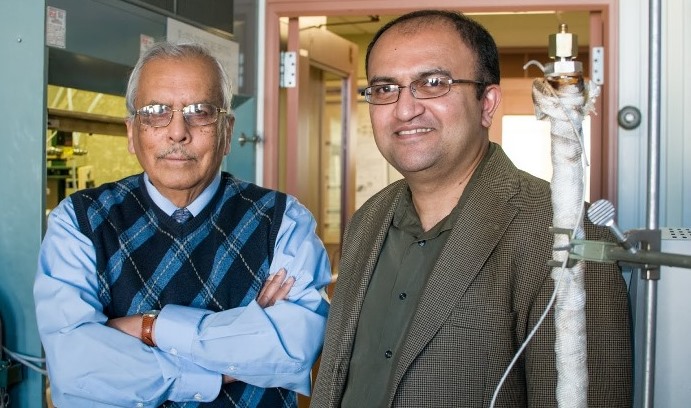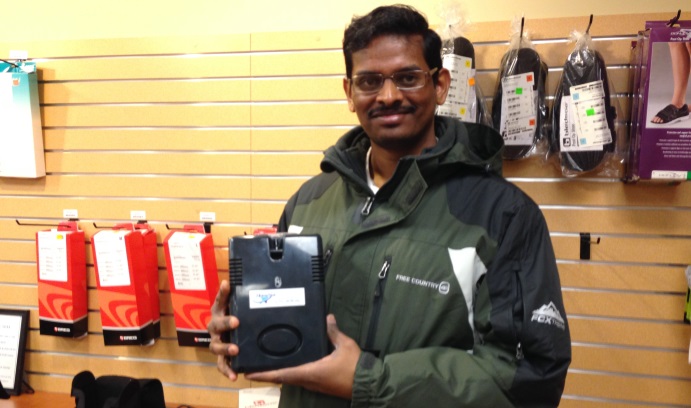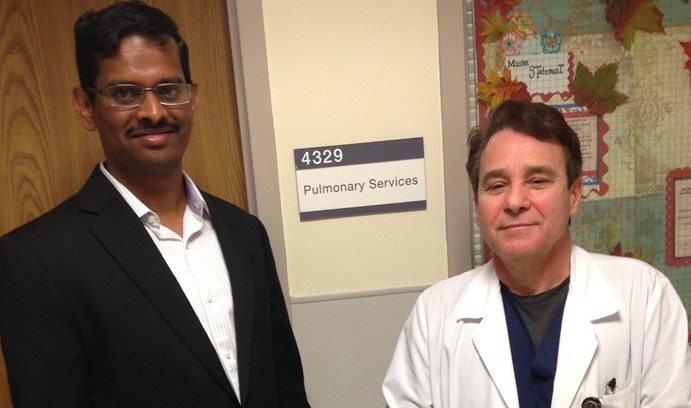Sizing up the market for a breathing device

Shivaji Sircar and Mayuresh Kothare say their bench-scale medical oxygen concentrator will significantly exceed the performance of commercially available MOCs and improve the quality of life for people with obstructive lung diseases.
If you’ve seen the growing number of TV ads for breathing devices, it won’t surprise you that the National Institutes of Health now ranks chronic obstructive pulmonary disease (COPD) as the third-leading cause of death in the United States.
COPD includes a suite of progressive and incurable illnesses, led by emphysema and chronic bronchitis, which reduce the quantity of air flowing in and out of the lungs. This reduction occurs when the tiny airways in the lung lose their elasticity, fill with mucus or become inflamed, or when the walls between airways are destroyed.
To get the oxygen they need, COPD patients were once confined to their beds and connected by breathing tubes to machines filled with compressed oxygen. To leave their homes, they had to carry a cylinder of oxygen or haul a tank on a dolly.
In the past two decades, portable, battery-operated medical oxygen concentrators (MOCs) weighing six to eight pounds have enabled many COPD patients to carry on daily activities and even travel.
Mayuresh Kothare, Shivaji Sircar and their students have developed a bench-scale model of an MOC that they believe will significantly exceed the performance of commercially available MOCs and improve the quality of life for COPD patients.
Kothare, the R. L. McCann Professor and department chair of chemical and biomolecular engineering, and Sircar, adjunct professor in the department, have spent five years working on the project. Kothare specializes in constrained and optimal predictive control theory. Sircar, a leading expert in adsorption science and technology for gas separation, has many years of industrial experience.
The group has been issued one patent with a second pending on a technology that would reduce an MOC’s weight while increasing its ability to recover oxygen from the air. In 2011, with help from Lehigh’s Office of Technology Transfer, the researchers won $200,000 in funding from the University Science Center in Philadelphia.
Since then, OTT has helped the group win two grants from the National Science Foundation to study the potential market for the MOC invention. The first came through NSF’s Innovation Corps (I-Corps) program. The second, awarded earlier this year, provided $200,000 through NSF’s Partnership for Innovation: Accelerating Innovation Research-Technology Translation (PFI:AIR-TT) program.
The support has helped the group build a working prototype while learning the entrepreneurial skills necessary to attract financial support and bring their product closer to market.
Smaller, lighter and faster
The bench-scale MOC developed by Kothare’s group improves on the current technology in several critical parameters.
Like most commercial MOCs, the Lehigh MOC can be plugged into a wall socket or operated with batteries. It uses a rapid pressure swing adsorption process (RPSA) to generate roughly 90-percent-pure oxygen from compressed ambient air that contains only about 21 percent oxygen.
The Lehigh design reduces the size of the device by employing a single column of adsorbent to separate nitrogen from oxygen, as opposed to the two or more columns found in conventional MOCs. The single-column scheme also allows the Lehigh design to use a simpler process control system employing fewer switching valves and related hardware.
The MOC design by the Lehigh group has also demonstrated the ability to produce 1 to 3 liters per minute or more of 90-percent-pure oxygen from compressed ambient air with process cycle times of just 3 to 6 seconds. This translates to a cycling frequency that is three to five times faster than that of commercial portable MOCs.
A distinct advantage of the Lehigh design is that it uses only a third of the adsorbent inventory (pellets of a type of zeolite, a microporous, aluminosilicate mineral) required by commercial MOCs. This lowers unit weight and increases compactness.
There are other major advantages to the Lehigh MOC. Its design allows for a continuous rather than a pulsed flow of oxygen, which is often preferred by users, while retaining the smaller adsorbent inventory advantage. The size and flow rate can be easily scaled up or down. A particular “snap on” concept allows the MOC to be hooked up with an existing compressed air line for oxygen production. This eliminates the need for a dedicated compressor, thereby significantly reducing weight while adding to portability. Compressed air lines are readily available in hospitals, cruise ships and commercial airplanes.
Thus, while current FDA-approved MOCs for ambulatory patients weigh 7-8 pounds and supply about 1 liter per minute of oxygen continuously, the Lehigh group hopes to reduce MOC weight to 4-5 pounds while increasing continuous oxygen supply to 2-4 liters per minute or more.
And while the batteries in commercially available MOCs need recharging after 4 hours, the goal of the Lehigh group is to increase this duration by about 25 percent.
The group recently published a technical article in the AIChE Journal stating that its experimental results “indicate that the adsorbent inventory of an MOC can be potentially reduced by a factor of three while offering a 10 to 20 percent higher oxygen recovery compared to a typical commercial unit.”
The bridge to the market
But the promising results will have little practical impact, says Kothare, unless “the gap between invention and commercial deployment is bridged.”
The NSF I-Corps and PFI:AIR-TT grants have helped the group take the first steps toward that goal, says Yatin Karpe, associate director of the Office of Technology Transfer.
“The goal of the I-Corps program,” says Karpe, “is to help researchers learn the needs of the customer and the market by conducting interviews. The PFI:AIR-TT grant will help researchers develop a ‘proof-of-invention’ prototype. Together, the two programs will help the researchers and OTT either start up a company to market this product or license the product to an existing company that will market it.”
Kothare and Vemula Rama Rao, a postdoctoral research scientist with experience in adsorptive gas separation, joined other I-Corps teams in attending workshops at the University of California at Berkeley to study supply chain management, marketing and business model canvassing. For a textbook, the aspiring entrepreneurs used The Startup Owner’s Manual: The Step-By-Step Guide for Building a Great Company by Steve Blank and Bob Dorf.
“The book tries to maximize a new business owner’s chances of success,” says Karpe.
The course helped the researchers refine their ability to explain their technology by making presentations to other Lehigh research teams and, via videoconferencing, to other I-Corps groups and to the Berkeley business faculty members who were their instructors.
“We learned from each other’s mistakes and from the faculty members at Berkeley,” says Kothare.
A trip to the corner oxygen bar
The group also completed an assignment from their Berkeley mentors by interviewing potential consumers of their product. These included doctors, patients, medical device manufacturers, valve manufacturers and companies that fabricate zeolite for adsorption manufacturers. By phone, by Skype and in person, the researchers interviewed 100 people. They visited suppliers of MOC equipment and hospitals that use that equipment. They even went to an oxygen bar on San Francisco’s Fisherman’s Wharf, where patrons breathe flavored oxygen and chat and watch TV.
After completing the I-Corps program, the researchers applied successfully for the PFI:AIR-TT grant from NSF. They are now building a prototype and talking with potential partners, including medical device companies. There are technical hurdles to overcome. The bench-scale model must be reduced in size to the dimensions of a book. This means smaller valves, compressors and interior hardware. The MOC design, which the group has validated at the bench scale, must now be confirmed at the device’s actual commercial size.
In addition to Rama Rao, a dozen students and research scientists have contributed to the progress of the project, says Kothare. Chin Wen Wu, a Ph.D. candidate, is helping to validate the design. Alison Graf and Alex Lincoln, who both earned a B.S. in chemical engineering in 2011, have assisted, as have students in Lehigh’s Master of Engineering program in Technical Entrepreneurship.
The group has published 12 scientific and technical papers in top journals and conference proceedings, receiving favorable reviews. Recently the researchers received a $50,000 Business Opportunity Validation Grant from the Life Sciences Greenhouse of Central Pennsylvania.
“The commercialization of a new product is a long process,” says Karpe. “No one is going to jump on your product because it sounds good—it has to look good, feel good and work well.
“Above all, it has to fit the needs of the customer and the market.”
Posted on:



